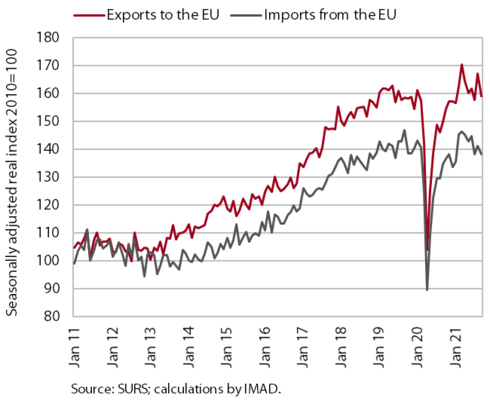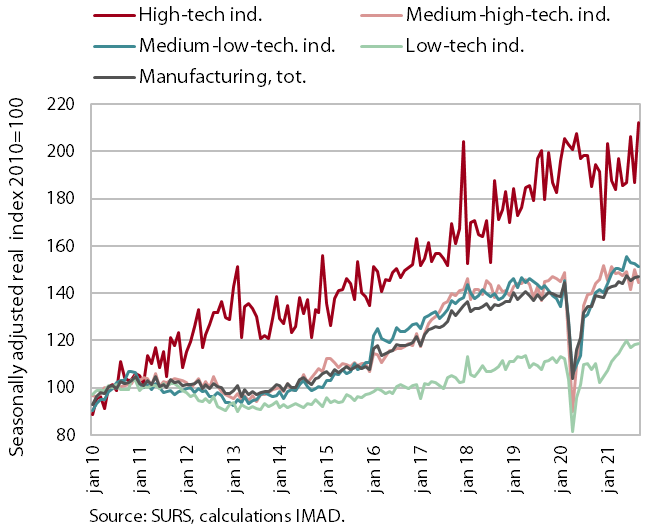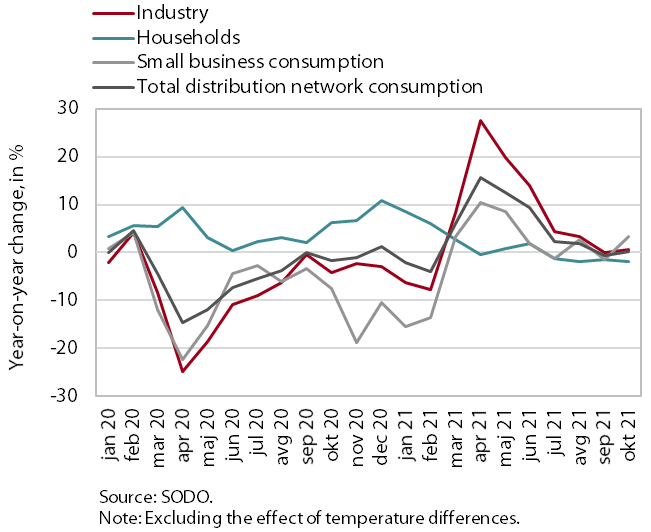Charts of the Week
Current economic trends from 8 to 12 November 2021: trade in goods, production volume in manufacturing and electricity consumption by consumption group
Trade in goods declined in the third quarter compared to the second quarter, while manufacturing output growth slowed due to supply chain disruptions. However, compared to the same period in 2019, both indicators were higher. In October, industrial electricity consumption and small business electricity consumption were higher year-on-year. Compared to the same period of 2019, the gap in industrial consumption widened, while the gap in small business consumption remained about the same as the previous month.
Trade in goods, September 2021

Trade in goods declined in the third quarter. Compared to the previous quarter, real exports of goods to EU Member States fell slightly in the third quarter (by 0.5%, seasonally adjusted), which we believe is related to supply chain disruptions. Shortages of electronic components and bottlenecks in the supply of raw materials have mainly affected the automotive and related industries in Slovenia and its main trading partners (Germany, France), leading to a decline in vehicle exports that remains well below the level of the same period in 2019. According to available data, the growth of exports of other main product groups (excluding metals and metal products) has also slowed down, but it continues to exceed the levels of the same period in 2019. Imports of goods from EU Member States also fell (by 3.5%, seasonally adjusted), especially imports of consumer goods (imports of passenger cars). Growth of imports of investment goods and intermediate goods also declined. At the beginning of the last quarter, export expectations are still higher than before the outbreak, and their monthly fluctuations indicate increased uncertainty, mainly related to the international environment.
Production volume in manufacturing, September 2021

Manufacturing output continued its upward trend in the third quarter, although growth slowed down. In addition to the current decline in July, this was also due to modest growth in September. In our estimation, this is due to the supply chain problems, which have hit the automotive industry and its suppliers the hardest. Quarter-on-quarter, activity increased the most in high-technology industries, while growth was more modest in medium-low and low-technology industries and declined in medium-high-technology industries, including the automotive industry. Manufacturing output growth was again relatively strong in the third quarter (9.7% in the third quarter and 29.4% in the second quarter), still partly due to the low base. Growth was also solid compared to the same quarter in 2019. The largest increase compared to the level of the third quarter last year was recorded by medium-low technology industries, and the lowest by medium-high technology industries, due to the decline in the automotive industry.
Electricity consumption by consumption group, October 2021

In October, industrial electricity consumption and small business electricity consumption were higher year-on-year. Compared to the same period of 2019, the gap in industrial consumption widened, while the gap in small business consumption remained about the same as the previous month. Compared to October last year, industrial electricity consumption was 0.7% higher and small business electricity consumption was 3.4% higher. The latter is mainly due to last year's low base, as containment measures were taken last October during the second wave of the epidemic, which mainly restricted trade and service activities. Household consumption fell by 1.8% year-on-year in October, probably because of lower restrictions on movement than last year. Industrial consumption was 3.6% lower than in October 2019 (Sep 21/Sep 19 by 0.6%), which was probably largely related to supply chain disruptions. Small business consumption was also lower (by 4.3%) than in October 2019 (Sep 21/Sep 19 by 4.8%), while household consumption was higher by 4.1%.
